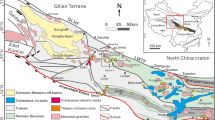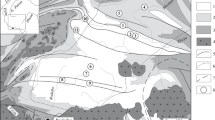Abstract
The rodingite belt in the Karabash massif situated 40 km north of Miass is continuously traced for 2.5 km along its central part. Rodingites bear up to 1% sulfide disseminations and gold particles with high Cu content (up to 40 wt %) throughout the belt. The central part of the rodingite belt is especially rich in gold, which was mined at the Zolotaya Gora (Gold Mountain) deposit. The Au-bearing rodingite belt is zonal and was formed during three stages. The inner zone is composed of chlorite-andradite-diopside rock of the first stage, which is crosscut by diopside veinlets of the second stage and calcite veinlets of the third stage. The intermediate zone consists of fine-grained chloritolite of the first stage and coarse-grained chlorite veinlets of the second stage. The outer zone of the metasomatic column is occupied by antigorite and chrysotile-lizardite serpentinites. No relict rocks or minerals of the replaced protolith have been established except sporadic Cr-spinel grains. Native gold was being deposited during all periods of rodingite formation. In terms of the currently adopted concept of evolution of the Ural Foldbelt, the Sm-Nd isochron age of rodingite estimated at 369.4 ± 8.8 Ma corresponds to the period of collisional compression of Silurian-Devonian oceanic and island-arc complexes and upward pushing out of a block of the melanocratic basement underlying these complexes. A proposed model of rodingite formation is based on ore mineralogy, REE geochemistry, and thermobarogeochemical and isotopic study of minerals. It is suggested that in contrast to the barren bimetasomatic rodingite replacing dikes, the studied rodingite are considered to be fissure veins accompanied by metasomatic alteration of host serpentinite. The estimation of initial isotopic composition of fluid components indicates that the ore-bearing fluid is of metamorphic origin (δDfl = −4 to −13‰ and δ18Ofl = 5.9 to 8.3‰). The fluid was formed as a product of dehydration of oceanic serpentinite at the base of melanocratic rocks and related gabbroids that moved out to the surface. These rocks were a source of gold and other components (Ca, Al, Ti, Cu, Ni, REE, P, etc.).
Similar content being viewed by others
References
Antonov, A.A., Mineralogiya rodingitov Bazhenovskogo giperbazitovogo massiva (Mineralogy of rodingite in the Bazhenovo ultramafic massif), St. Petersburg: Nauka, 2003.
Attoh, K., Evans, M.J., and Bickford, M.E., Geochemistry of an ultramafic-rodingite rock association in the Paleoproterozoic Dixcove Greenstone Belt, southwestern Ghana, J. African Earth Sci., 2005, vol. 45, no. 3, pp. 333–346.
Bau, M., Rare-earth element mobility during hydrothermal and metamorphic fluid-rock interaction and the significance of the oxidation state of europium, Chem. Geol., 1991, vol. 93, no. 3/4, pp. 219–230.
Belogub, E.V., Udachin, V.N., and Korablev, G.G., Karabash ore district, the Southern Ural, in Materialy k putevoditelyu geologo-ekologicheskoi ekskursii (Appendices to the guidebook of geological-environmental excursion), Miass: IMin UrO RAN, 2003.
Berzon, R.O., Zolotonosnost giperbazitov (Gold resource potential of ultramafics), Moscow: VIEMS, 1983.
Berzon, R.O. and Borodaevsky, N.I., Zolotay Gora deposit, in Zolotorudnye mestorozhdeniya SSSR. T.1 (Gold Deposits of the USSR), Moscow: Nedra, 1984, vol. 1.
Betekhtin, A.G., Genkin, A.D., Filimonova, A.A., and Shadlun, T.N., Tekstury i struktury rud (Structures and Textures of Ores), Moscow: Gosgeoltekhizdat, 1958.
Borodaevsky, N.I., Types of gold deposits related to ultramafic rocks in the Miass and Uchaly districts in the southern Urals, in 200 let zolotoi promyshlennosti Urala (200 years of gold industry of the Urals), Sverdlovsk: UFAN SSSR, 1948, pp. 316–330.
Bortnikov, N.S., Geochemistry and origin of the ore-forming fluids in hydrothermal-magmatic systems in tectonically active zones, Geol. Ore Deposits, 2006, vol. 48, no. 1, pp. 1–22.
Chashchukhin, I.S., Mamina, V.M., Surganov, A.V., et al., Composition of accessory and ore-forming Cr-spinel in ultramafic rocks in the Pervomaisky massif, Yearbook-2003, Yekaterinburg: Inst. Geol. Geochem., Ural Branch, Russian Acad. Sci., 2004, pp. 206–217.
Chashchukhin, I.S. and Votyakov, S.L., Crystal chemistry of serpentine-group minerals as an indicator of early serpentinization in ultramafites: II. Serpentinization facies and sources of serpentinizing water, Geochem. Int, 2005, vol. 43, no. 10, pp. 959–972.
Damdinov, B.B., Zhmodik, S.M., Mironov, A.G., and Ochirov, Yu.Ch., Noble-metal mineralization in rodingite of the southeastern part of the Eastern Sayan, Geol. Geofiz., 2004, vol. 45, no. 5, pp. 577–587.
Dubinska, E., Rodingites and amphibolites from the serpentinites surrounding Gory Sowie Block (Lower Silesia, Poland): record of supra-subduction zone magmatism and serpentinization, N. Jahrb. Mineral. Abh., 1997, vol. 171, no. 3, pp. 239–279.
Efimov, V.I., Rodingites of the Bazhenovo chrysotile asbestos, Ural. Geol. Zh., 2004, no. 2, pp. 93–122.
Erokhin, Yu.V., Rodingitization of high-Ti diorite dikes in the Bazhenovo ultramafic massif, Yearbook-2004, Yekaterinburg: Inst. Geol. Geochem., Ural Branch, Russian Acad. Sci., 2005, pp. 211–215.
Erokhin, Yu.V., Finding of “classic” rodingite in the Karabash ultramafic massif, the Southern Ural, in Ul’trabazitbazitovye kompleksy skladchatykh oblastei i svyazannye s nimi mestorozhdeniya: Mater. III mezhdunar. konf. T.1. (Abstracts of the 3rd Intern. Conference on mafic-ultramafic complexes of folded regions and related deposits), Yekaterinburg, 2009, vol. 1, pp. 173–175.
Evensen, N.M., Hamilton, P.J., and Nions, R.K., Rareearth abundances in chondritic meteorites, Geochim. Cosmochim. Acta, 1978, vol. 42, pp. 1199–1212.
Faure, G., Principles of isotope geology, 2nd Ed., New York: Wiley, 1986; Moscow: Mir, 1989.
Gorelova, N.N., Manifestations of local metasomatism and related mineralization in an ultramafic massif of the Koryak Highland, Izv. Vyssh. Uchebn. Zaved., Geol. Razved., 1990, no. 2, pp. 73–78.
Kepezhinskas, K.B. and Tomilenko, A.A., Dynamics of variation of fluid composition in the process of metamorphism of rocks in ophiolitic zones: a case of eastern Khubsugul region, Dokl. Akad. Nauk SSSR, 1985, vol. 285, no. 4, pp. 963–966.
Hoefs, J., Stable isotope geochemistry, Berlin: Springer, 1980; Moscow: Mir, 1983.
Knight, J. and Leitch, C.H.B., Phase relations in the system Au-Cu-Ag at low temperatures, based on natural assemblages, Can. Miner., 2001, vol. 39, pp. 889–905.
Kolonin, G.R., Physicochemical properties of europium as a possible marker of mineral formation conditions, Dokl. Earth Sci., 2006, vol. 408, no. 4, pp. 649–651.
Kuznetsov, E.A., Petrographic description of the Soimanov Valley, the Sugur Mountains and Mount Karabash, Trudy in-ta prikladnoi mineralogii i metallurgii (Proceedings of Institute of Applied Mineralogy and Metallurgy),1928, no. 37.
Leblanc, M. and Lbouabi, M., Native silver mineralization along a rodingite tectonic contact between serpentinite and quartz diorite (Bou Azzer, Morocco), Econ. Geol., 1988, vol. 83, pp. 1379–1391.
Likhoidov, G.G. and Plyusnina, L.P., Rodingites of northern Sakhalin and their physicochemical formation conditions, Tikhookean. Geol., 1992, no. 2, pp. 53–65.
Lozhechkin, M.P., The Karabash deposit of cupriferous gold, Trudy UFAN SSSR, 1935, no. 4, pp. 35–44.
Ludwig, K.R., User’s manual for ISOPLOT 3.6. A geochronological toolkit for Microsoft Excel, Berkeley Geochronology Center, Spec. Publ., 2008, no. 4.
Murzin, V.V., Origin of fluids responsible for the formation of Au-bearing rodingites based on isotope data: evidence from the Karabash Alpine-type ultramafic massif, the Southern Urals, Dokl. Earth Sci., 2006, vol. 407, no. 2, pp. 254–257.
Murzin, V.V., Kudryavtsev, V.I., Berzon, R.O., and Sustavov, S.G., Cupriferous gold in zones of rodingitization, Geol. Rudn. Mestorozhd., 1987, vol. 29, no. 5, pp. 96–99.
Murzin, V.V., Sazonov, V.N., Varlamov, D.A., and Shanina, S.N., Gold mineralization in rodingite of Alpine-type ultramafic massifs, Litosfera, 2006, no. 1, pp. 113–134.
Murzin, V.V. and Shanina, S.N., Fluid regime and origin of gold-bearing rodingites from the Karabash Alpine-type ultrabasic massif, the Southern Ural, Geokhem. Int., 2007, vol. 45, no. 10, pp. 998–1011.
Murzin, V.V. and Sustavov, S.G., Solid-state transformations in natural cupriferous gold, Izv. Akad. Nauk SSSR, Ser. Geol., 1989, no. 11, pp. 94–104.
Murzin, V.V., Varlamov, D.A., Popov, V.A., et al., Mineralogy and geochemistry of gold-rare-metal-REE mineralization in chlorite-carbonate rocks of the Karabash ultramafic massif, the southern Ural, Ural. Miner. Sbornik, 2005, no. 13, pp. 123–145.
Murzin, V.V., Varlamov, D.A., and Shanina, S.N., New data on the gold-antigorite association of the Urals, Dokl. Earth Sci., 2007, vol. 417A, no. 9, pp. 1436–1439.
Novgorodova, M.I., Tsepin, A.I., Kudrevich, I.M., and Vyal’sov, L.N., New data on crystal chemistry and properties of natural intermetallic compounds in the copper-gold system, Zap. VMO, 1977, vol. 106, no. 5, pp. 540–552.
Perelyaev, A.P., Zolotaya Gora deposit, in 200 let zolotoi promyshlennosti Urala (200 years of gold industry in the Urals), Sverdlovsk: UFAN SSSR, 1948, pp. 285–295.
Petrovskaya, N.V., Notion of paragenetic mineral assemblage, Geol. Rudn. Mestorozhd., 1967, vol. 9, no. 2, pp. 69–78.
Plyusnina, L.P. and Likhoidov, G.G., Contact reaction interaction of granitoids and gabbro with ultramafic rocks and its effect on gold and platinum mobility, Tikhookean. Geol., 1997, vol. 16, no. 4, pp. 95–101.
Plyusnina, L.P., Likhoidov, G.G., and Kuz’mina, T.V., Gold and fluid regime of listvenitization, Litosfera, 2009, no. 5, pp. 85–90.
Plyusnina, L.P., Likhoidov, G.G., and Zaraisky, G.P., Physicochemical formation conditions of rodingite from experimental data, Petrologiya, 1993, vol. 1, no. 5, pp. 557–568.
Pokrovsky, P.V., Murzin, V.V., Berzon, R.O., and Yunikov, B.A., Mineralogy of native gold at the Zolotaya Gora deposit, Zap. VMO, 1979, vol. 108, no. 3, pp. 317–326.
Rakhov, E.V., Behavior of aluminum in chloritization zones in ultramafic rocks, in Yearbook-2004, Yekaterinburg: Inst. Geol. Geochem., Ural Branch, Russian Acad. Sci., 2005, pp. 206–211.
Rechkin, A.N., A new type of gold mineralization in ultramafic rocks, Geol. Geofiz., 1974, vol. 15, no. 2, pp. 49–53.
Ronkin, Yu.L., Shardakova, G.Yu., Maslov, A.V., Shagalov, E.S., and Lepikhina, O.P., Granitoids of the Ufalei Block (South Urals): Sr-Nd isotope systematics, geodynamic position and genetic reconstructions, Strat. Geol. Correlation, 2009, vol. 17, no. 2, pp. 137–145.
Sazonov, V.N., Zolotoproduktivnye metasomaticheskie formatsii podvizhnykh poyasov (geodinamicheskie obstanovki i RTKh-parametry obrazovaniya, prognosticheskoe znachenie) (Gold-productive metasomatic rocks in mobile belts: geodynamic settings and PTX parameters of their formation and implications for forecasting), Yekaterinburg: UGGGA, 1998.
Seravkin, I.B., Znamensky, S.E., and Kosarev, A.M., The Main Ural Fault in the South Urals: the structure and main evolution phases, Geotectonics, 2003, vol. 37, no. 3, pp. 42–64.
Skublov, S.G., Geokhimiya redkozemel’nykh elementov v porodoobrazuyushchikh metamorficheskikh mineralakh (Geochemistry of rare earth elements in metamorphic rock-forming minerals), St. Petersburg: Nauka, 2005.
Smirnov, V.I., Geologiya poleznykh iskopaemykh (Geology of mineral resources), Moscow: Nedra, 1982.
Snachev, V.I., Savel’ev, D.E., and Rykus, M.V., Petrokhimicheskie osobennosti porod i rud gabbro-giperbazitovykh massivov Kraka (Petrochemistry of rocks and ores in the Kraka gabbro-ultramafic massifs), Ufa: Inst. Geol., 2001.
Sokolova, L.A., Petrography of rocks from the Bazhenovo chrysotile asbestos deposit and metamorphism of these rocks, Trudy IGEM AN SSSR, 1960, no. 47, pp. 3–42.
Spiridonov, E.M. and Pletnev, P.A., Mestorozhdenie medistogo zolota Zolotaya Gora (Zolotaya Gora deposit of cupriferous gold), Moscow: Nauchnyi mir, 2002.
Tatarinov, P.M., Chrysotile asbestos deposit of the Bazhenovo district in the Urals, Trudy Geolkom, 1928, no. 185, pp. 1–90.
Taylor, H.P., Jr., The application of oxygen and hydrogen isotope studies to problems of hydrothermal alteration and ore deposition, Econ. Geol., 1974, vol. 69, pp. 843–883.
Yurkova, R.M. and Voronin, B.I., Gold mineralization in rodingites, in Problemy geologii rudnykh mestorozhdenii, mineralogii, petrologii i geokhimii: Mater. Nauchn. konf., posvyashchennoi 100-letiyu so dnya rozhdeniya akademika F.V. Chukhrova (Proccedings of sci. conference on geology of ore deposits, mineralogy, petrology, and geochemistry), Moscow: IGEM RAN, 2008, pp. 377–380.
Zhmodik, S.M., Mironov, A.G., Derevenets, V.G., et al., A new type of tin-(mercury)-gold-PGE ore mineralization in the Eastern Sayan Range, Dokl. Earth Sci., 1998, vol. 361A, no. 6, pp. 782–785.
Znamensky, S.E., Strukturnye usloviya formirovaniya kollizionnykh mestorozhdenii zolota vostochnogo sklona Yuzhnogo Urala (Structural formation conditions of collisional gold deposits on the eastern slope of the southern Ural), Ufa: Gilem, 2009.
Author information
Authors and Affiliations
Corresponding author
Additional information
Original Russian Text © V.V. Murzin, D.A. Varlamov, Yu.L. Ronkin, S.N. Shanina, 2013, published in Geologiya Rudnykh Mestorozhdenii, 2013, Vol. 55, No. 4, pp. 320–341.
Rights and permissions
About this article
Cite this article
Murzin, V.V., Varlamov, D.A., Ronkin, Y.L. et al. Origin of Au-bearing rodingite in the Karabash massif of alpine-type ultramafic rocks in the southern Urals. Geol. Ore Deposits 55, 278–297 (2013). https://doi.org/10.1134/S1075701513040053
Received:
Published:
Issue Date:
DOI: https://doi.org/10.1134/S1075701513040053




